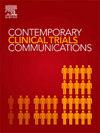Effectiveness of electrical stimulation with conservative treatment for lower urinary tract symptoms in Parkinson's disease: A three-armed randomized controlled trial protocol
IF 1.4
Q4 MEDICINE, RESEARCH & EXPERIMENTAL
引用次数: 0
Abstract
Background
Despite the high prevalence of lower urinary tract symptoms (LUTS) in patients with Parkinson's disease (PD)—ranging from 27 % to 85 % including symptoms such as urinary urgency,- incontinence, frequency, and nocturia—evidence-based treatment options remain limited. Conservative treatments, such as bladder training, pelvic floor muscle exercises (PFME) with biofeedback and electrical stimulation, have been shown safe and effective in the general population, with minimal side effects. However, their efficacy specifically in PD patients remains unclear. Therefore this study aims to evaluate the effect of electrical stimulation with conservative treatment for LUTS in PD patients.
Methods and analysis
This randomized controlled trial includes three study arms. All three groups will receive conservative treatment in combination with different electrical stimulation parameters, small- and broad pulse duration and sham electrical stimulation. In total 150 PD patients with self-reported LUTS who are able to attend a pelvic physical therapy practice independently and complete online questionnaires will be enrolled. The primary outcome is the difference in international prostate symptom score (IPSS), with a range of 0–35.
A minimal important difference of 4.2 between baseline and 12 weeks of treatment will be statistical significant (p˂0.05). Secondary outcome include questionnaires evaluating bladder dysfunction, burden, and quality of life and will be collected at baseline, 12 weeks and 24 weeks and at one year. Additionally pelvic floor muscle function will be assed at baseline and after 12 weeks.
All participants receive eight sessions along with their assigned electrical stimulation treatment and conservative treatment.
电刺激加保守治疗帕金森病下尿路症状的有效性:一项三手随机对照试验方案
背景:尽管下尿路症状(LUTS)在帕金森病(PD)患者中的患病率很高,从27%到85%不等,包括尿急、尿失禁、尿频和夜尿等症状,但循证治疗方案仍然有限。保守治疗,如膀胱训练、骨盆底肌肉运动(PFME)与生物反馈和电刺激,已被证明在一般人群中安全有效,副作用最小。然而,它们在PD患者中的具体疗效尚不清楚。因此,本研究旨在评价电刺激联合保守治疗PD患者LUTS的效果。方法与分析本随机对照试验包括三个研究组。三组均采用保守治疗,结合不同的电刺激参数、小脉冲和宽脉冲持续时间以及假电刺激。总共150名自我报告LUTS的PD患者将被招募,这些患者能够独立参加盆腔物理治疗实践并完成在线问卷。主要结果是国际前列腺症状评分(IPSS)的差异,范围为0-35。基线和12周治疗之间的最小重要差异为4.2,具有统计学意义(p小于0.05)。次要结局包括评估膀胱功能障碍、负担和生活质量的问卷,并将在基线、12周、24周和1年时收集。此外,盆底肌肉功能将在基线和12周后进行评估。所有参与者都接受了8个疗程的电刺激治疗和保守治疗。
本文章由计算机程序翻译,如有差异,请以英文原文为准。
求助全文
约1分钟内获得全文
求助全文
来源期刊

Contemporary Clinical Trials Communications
Pharmacology, Toxicology and Pharmaceutics-Pharmacology
CiteScore
2.70
自引率
6.70%
发文量
146
审稿时长
20 weeks
期刊介绍:
Contemporary Clinical Trials Communications is an international peer reviewed open access journal that publishes articles pertaining to all aspects of clinical trials, including, but not limited to, design, conduct, analysis, regulation and ethics. Manuscripts submitted should appeal to a readership drawn from a wide range of disciplines including medicine, life science, pharmaceutical science, biostatistics, epidemiology, computer science, management science, behavioral science, and bioethics. Contemporary Clinical Trials Communications is unique in that it is outside the confines of disease specifications, and it strives to increase the transparency of medical research and reduce publication bias by publishing scientifically valid original research findings irrespective of their perceived importance, significance or impact. Both randomized and non-randomized trials are within the scope of the Journal. Some common topics include trial design rationale and methods, operational methodologies and challenges, and positive and negative trial results. In addition to original research, the Journal also welcomes other types of communications including, but are not limited to, methodology reviews, perspectives and discussions. Through timely dissemination of advances in clinical trials, the goal of Contemporary Clinical Trials Communications is to serve as a platform to enhance the communication and collaboration within the global clinical trials community that ultimately advances this field of research for the benefit of patients.
 求助内容:
求助内容: 应助结果提醒方式:
应助结果提醒方式:


